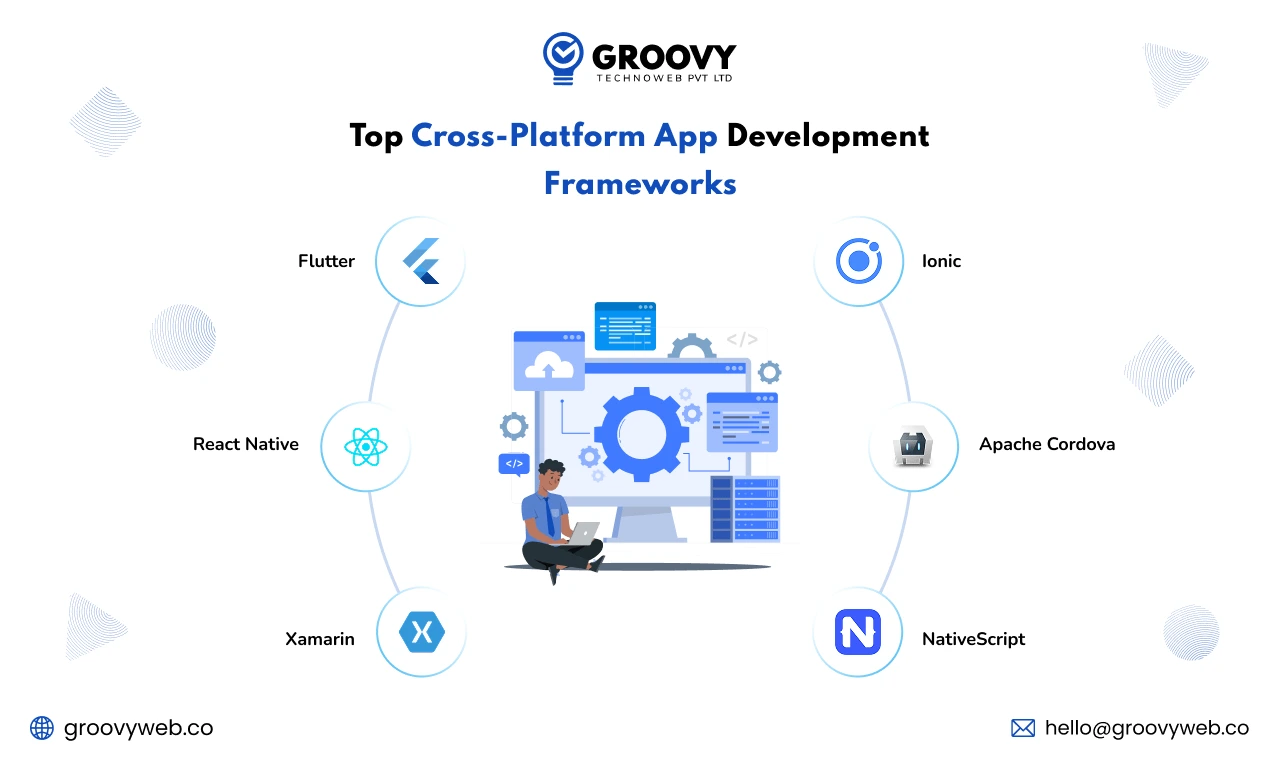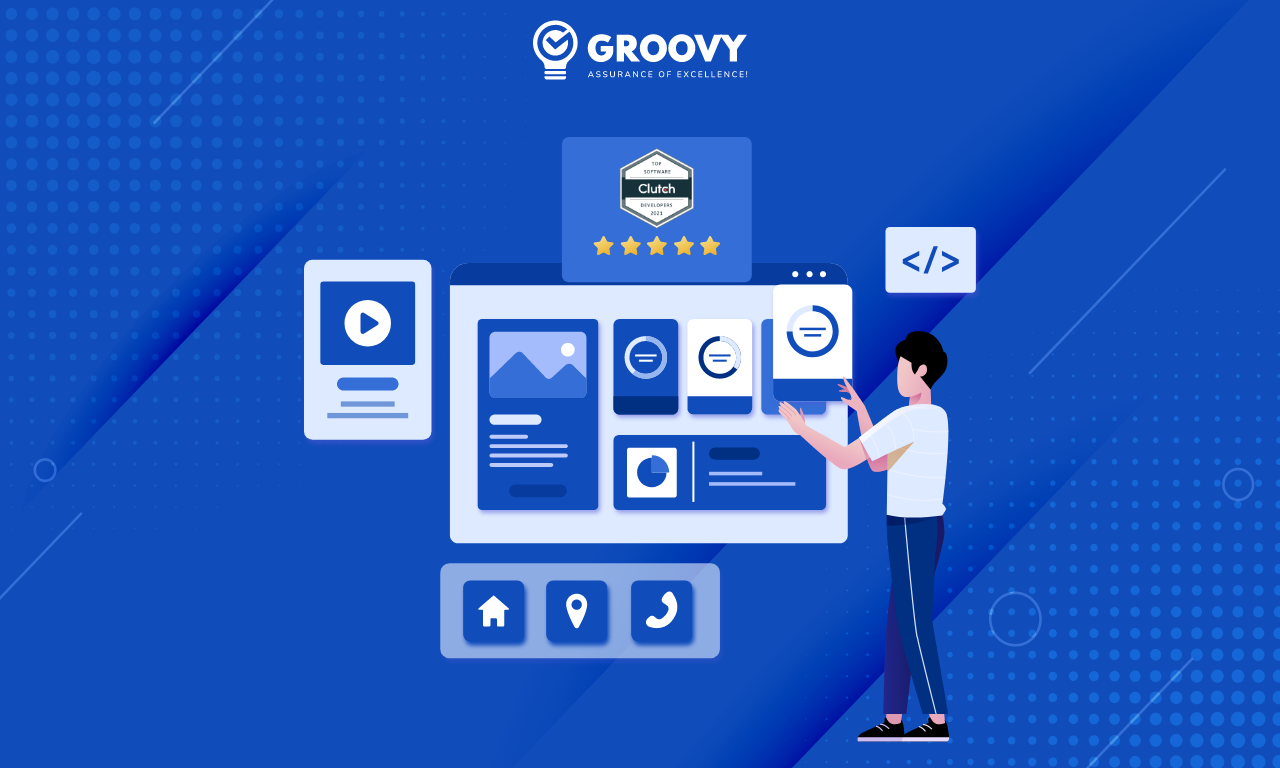Best Cross-Platform App Development Frameworks in 2025
Sagar Patel
April 10, 2025 15 Views
Quick Summary : Cross-platform app development has become the preferred choice for businesses aiming to launch mobile apps efficiently across both Android and iOS platforms. By using a single codebase, companies can reduce costs, speed up development, and maintain a consistent user experience. This blog outlines the top frameworks in 2025 such as Flutter, React Native, Xamarin, and more while highlighting key factors to consider, pros and cons of each framework, and expert recommendations. With Groovy Technoweb's cross-platform development expertise, businesses can confidently choose the right technology stack
With a more mobile-first world, companies need to reach their users where they’re already spending their time. There were more than 255 billion mobile app downloads worldwide in 2022 alone, and that number is still climbing in 2025, as per Statista. Apps are no longer a nicety, they’re a necessity. But developing two different apps for Android and iOS can be costly and time-consuming. This is why such startups and companies are resorting to cross-platform app development platforms to develop applications more quickly and economically.
Cross-platform frameworks allow developers to leverage one codebase to deploy apps on various platforms, saving a tremendous amount of development time and money. Groovy technoweb pvt ltd is an expert in assisting startups and enterprises in utilizing the best cross-platform tools to develop a custom software that is scalable, high-performing, and easy to manage.
In this blog, we will compare the best cross-platform frameworks in 2025, their pros and cons, and assist you in choosing the best framework for your business. We will also provide best practices, cost projections, and future trends to inform your decision-making process.
What is Cross-Platform App Development?
Cross-platform development is gaining popularity because it helps businesses maximize reach while minimizing effort. Instead of managing two separate teams for Android and iOS, companies can now rely on a single development cycle. This not only speeds up the time-to-market but also allows for more consistent branding and user experience across platforms. Tools like Flutter and React Native have made it easier than ever to build robust apps without compromising on quality or performance.
From a business perspective, cross-platform development is especially beneficial for startups and SMEs with limited resources. Since you’re maintaining only one codebase, ongoing maintenance, updates, and testing become more streamlined, saving time and reducing long-term operational costs. Groovy, help their clients to choose the best frameworks and follow best practices to ensure their apps run seamlessly on both Android and iOS devices offering users a native-like experience without doubling development efforts.

Why Choose Cross-Platform Over Native Development?
Traditionally, companies had to build two separate apps, one for iOS using Swift or Objective-C, and another for Android using Java or Kotlin. This approach, while powerful, comes with high development and maintenance costs.
Cross-platform development offers a smarter alternative:
- Cost Efficiency: Reduces overall development costs by up to 40%.
- Faster Time-to-Market: A shared codebase accelerates the release cycle.
- Easier Maintenance: Fix bugs or release updates once, and they apply to both platforms.
- Wider Audience Reach: Instantly available to both Android and iOS users.
Importance of Choosing the Right Framework
Choosing the right cross-platform framework can significantly impact your app’s performance, scalability, and user satisfaction. A poor choice might lead to performance issues, delayed launch, or excessive costs. That’s why it’s essential to evaluate your business needs, app complexity, and team skills before making a decision.
Each cross-platform framework comes with its own strengths, limitations, and ideal use cases. For instance, Flutter is best suited for visually rich and performance-intensive applications, while React Native is great for rapid development and teams already familiar with JavaScript. Ionic or Cordova might work well for simple internal apps or prototypes, but they may not meet the performance demands of complex consumer-facing platforms. Selecting a framework without understanding these nuances can result in an app that feels sluggish, lacks essential features, or fails to meet user expectations.
Moreover, the right framework can affect everything from your app’s future updates to its ability to scale as your business grows. Frameworks with strong community support, frequent updates, and active development like Flutter and React Native ensure your app remains up-to-date with the latest mobile OS changes. At Groovy technoweb, we don’t just build apps; we consult with clients to evaluate every angle, including cost, timeline, target audience, and future growth, so we can recommend the most sustainable and scalable cross-platform app development solution for your unique business goals.
What is a Cross-Platform App Development Frameworks?
A cross-platform app development framework is a software toolkit that enables developers to build mobile apps that can run on multiple platforms using a single programming language. These frameworks provide APIs, libraries, and tools that streamline development and ensure compatibility across platforms.
How It Works
Most frameworks use a common language (like JavaScript, Dart, or C#) and provide a bridge to access native APIs. Some, like Flutter, compile directly into native code, while others rely on WebView or JavaScript bridges.
Key Advantages
- Code Reusability: Share up to 90% of code between platforms.
- Unified UI/UX: Ensure consistent design across devices.
- Faster Testing: Simplify QA processes with one codebase.
- Lower Maintenance Costs: One team can handle everything.
Using the right framework enables companies to innovate quickly and reduce time-to-market, a priority for startups looking to launch MVPs efficiently.
If you’re exploring the best tools and modern approaches for cross-platform app development, don’t miss our in-depth guide on How to Develop a Cross-Platform App. This blog breaks down essential frameworks, toolkits, and trends to help you build faster, smarter, and more scalable apps in 2025.
Top Cross-Platform App Development Frameworks in 2025

1. Flutter
Developed by: Google Language: Dart Flutter is a UI toolkit that compiles directly into native ARM code. It’s known for delivering high-performance applications with stunning visuals.
Pros:
- High-speed performance thanks to native compilation.
- Rich widget library for beautiful and customizable UI.
- Hot reload accelerates development and testing.
- Strong community and Google support.
Cons:
- Larger app size compared to native.
- Dart language may be unfamiliar to new developers.
- Still catching up in third-party library support.
Best For: Apps with custom UIs, MVPs, and businesses that prioritize visual design.
Explore Groovy’s Flutter app development services to see how we create high-performance apps with Flutter.
2. React Native
Developed by: Meta(Facebook) Language: JavaScript React Native enables developers to build mobile apps using React and JavaScript, with native components under the hood.
Pros:
- Strong community and third-party library ecosystem.
- Reuse code with React web apps.
- Active development and support from Meta.
Cons:
- Performance lag in complex animations.
- Relies on third-party modules for advanced features.
Best For: Startups familiar with JavaScript, MVPs, and apps needing quick deployment.
Check Groovy Technoweb’s React Native Case Studies for real-world examples of successful app launches.
3. Xamarin
Developed by: Microsoft Language: C# Xamarin is integrated with the .NET ecosystem and is favored by enterprises using Microsoft technologies.
Pros:
- Native API access.
- Great performance for enterprise-grade apps.
- Strong integration with Azure and Visual Studio.
Cons:
- Less flexibility in UI customization.
- Smaller community than Flutter or React Native.
Best For: Enterprise apps and businesses already using the Microsoft stack.
4. Ionic
Language: HTML, CSS, JavaScript Ionic is ideal for building hybrid mobile apps using familiar web technologies. It uses WebView for rendering.
Pros:
- Web developers can quickly get started.
- Pre-built UI components.
- Compatible with Angular, Vue, and React.
Cons:
- Heavily reliant on WebView, which can impact performance.
- Not suitable for heavy animation or gaming apps.
Best For: Rapid prototyping, internal business apps, and cross-functional teams.
5. Apache Cordova
Cordova is a legacy hybrid framework that packages HTML, CSS, and JavaScript apps into native containers.
Pros:
- Longstanding support base.
- Easy to use for web developers.
Cons:
- Outdated architecture.
- Poor performance compared to modern tools.
Best For: Legacy support or apps with minimal UI/UX requirements.
6. NativeScript
Language: JavaScript, TypeScript NativeScript enables direct access to native APIs and UI rendering using Angular, Vue, or plain JS.
Pros:
- True native performance.
- Supports advanced UI customization.
Cons:
- Smaller community.
- Slower buildings and limited resources.
Best For: UI-intensive apps and developers seeking more native control.
According to research, 46% of developers used Flutter, while 35% used React Native, indicating Flutter’s growing dominance in cross-platform development.
Key Factors to Consider When Choosing an app development framework
- Performance & Speed: Important for gaming, finance, and real-time communication apps.
- UI/UX Customization: Choose frameworks that offer near-native UI experiences.
- Community Support: A larger community means more resources, plugins, and support.
- Developer Skill Set: Consider the language your developers already know.
- Long-Term Viability: Opt for frameworks with strong corporate backing and community activity.
- Cost Efficiency: Evaluate licensing, hosting, and developer costs.
Being a leading cross platform app development company, we help you evaluate these factors based on your unique business case, ensuring you select the right tech stack for sustainable success.
Cross-Platform vs. Native App Development – Which One Should You Choose?
| Feature | Cross-Platform | Native App Development |
| Performance | Moderate to High | Very High |
| Development Time | Faster | Slower |
| Cost | Lower | Higher |
| Maintenance | Easier | More Complex |
| Code Reuse | High | None |
| UI Flexibility | Good | Excellent |
Choose Cross-Platform When:
- You need to build an MVP quickly.
- You have a limited budget.
- You want to reach both Android and iOS users simultaneously.
Choose Native App Development Framework When:
- You need the best possible performance (e.g., gaming, AR).
- Your app relies heavily on platform-specific features.
How Much Does It Cost to Develop a Cross-Platform App?
Costs can vary depending on the framework, features, and app complexity:
Simple app: $5,000 – $15,000
Medium complexity: $15,000 – $35,000
Advanced features: $35,000+
The global revenue in the app market is forecasted to continuously increase, reaching approximately $673.78 billion by 2027.
For a detailed estimate, use our App Development Cost Calculator to explore cost ranges tailored to your project.
Factors influencing cost:
- Number of screens and user roles
- API integrations (payment gateway, chat, maps)
- Custom UI components
- Backend infrastructure
At Groovy, we understand that budget is often the deciding factor for startups and growing businesses. That’s why we provide end-to-end consultation, helping you pick the most suitable tech stack and cross-platform framework based on your budget, goals, and timeline. Whether you’re building a simple MVP or a feature-rich enterprise app, our transparent pricing model ensures you know exactly what you’re paying for with no hidden costs.
From concept to deployment, we focus on delivering maximum value for your investment by using proven development practices, reusable components, and frameworks that scale with your business.
Best Practices for Developing a High-Performance Cross-Platform App
- Optimize for both iOS and Android: Use platform-specific components where needed.
- Reduce app size: Minify assets and remove unused libraries.
- Improve app speed: Implement lazy loading and efficient memory management.
- Ensure UI consistency: Follow platform design guidelines.
- Test across devices: Emulators alone aren’t enough.
Groovy Technoweb Pvt Ltd. ensures every cross-platform app is thoroughly tested, optimized, and launched with excellence.
Final Thoughts & Recommendations
Cross-platform frameworks are becoming the go-to solution for businesses that want to build efficient, scalable, and cost-effective mobile apps.
Which Framework Should You Choose?
- Flutter: Great for UI-heavy apps and startups.
- React Native: Perfect for JavaScript teams.
- Xamarin: Ideal for enterprise-level Microsoft environments.
- Ionic/Native Script: Good for rapid prototyping and UI-heavy apps.
Future Trends in Cross-Platform Development
- AI-powered coding tools like GitHub Copilot
- Increased support for Web Assembly
- Rise of Progressive Web Apps (PWAs)
Why Choose Groovy Technoweb?
Groovy is a leading mobile app development company specializing in cross-platform mobile solutions. With 500+ successful projects under our belt, we help startups and enterprises build apps that are fast, reliable, and ready to scale. Our team of experts ensures your vision is brought to life using modern tools like Flutter, React Native, and more.
Written by: Sagar Patel
Sagar Patel is the CTO and Co-founder of Groovy Web. He was involved in the telecommunications & Automation industry during his early career. Still, due to his attitude toward learning anything new and mastering it, he now works as a CTO for Groovy Web. Through their business mindset and logical approach, they have taken their company to the next level; His responsibilities now include all aspects of the business. Among them are finance, process design, and development.
Frequently Asked Questions
We hope these clear your doubts, but if you still have any questions, then feel free to write us on hello@groovyweb.coWhich are the top cross-platform frameworks to consider in 2025?
Some of the most popular and widely used frameworks include Flutter, React Native, Xamarin, Ionic, Apache Cordova, and NativeScript. Each has its strengths and is suited for different types of projects and business needs.
Why should a business choose cross-platform development over native development?
Cross-platform development is ideal for businesses aiming to reach a wider audience quickly without the time and cost involved in developing separate apps for different platforms. It also simplifies updates and maintenance.
How can I estimate the cost of developing a cross-platform app?
App development costs vary depending on the features, complexity, design requirements, and technology stack. Using a cost calculator or consulting with a development partner like Groovy Web can help provide a tailored estimate.
Is cross-platform development suitable for enterprise-level apps?
Yes, with the right framework and experienced developers, cross-platform development can deliver highly scalable, secure, and enterprise-grade applications that perform well across all devices.
Related Blog

Nauman Pathan
Why Cloud Computing Is Important for Your Business
Software Development 02 Feb 2023 17 min read
Krunal Panchal
Groovy Web LLP Is One Of The Best Web Developers In India According To Clutch
Achivements 13 Nov 2024 2 min read
Kartik Bhaviyash
Groovy Recognized as a Clutch 100 Award Winner for Fast Growth
Achivements 04 Apr 2025 5 min readSign up for the free Newsletter
For exclusive strategies not found on the blog
